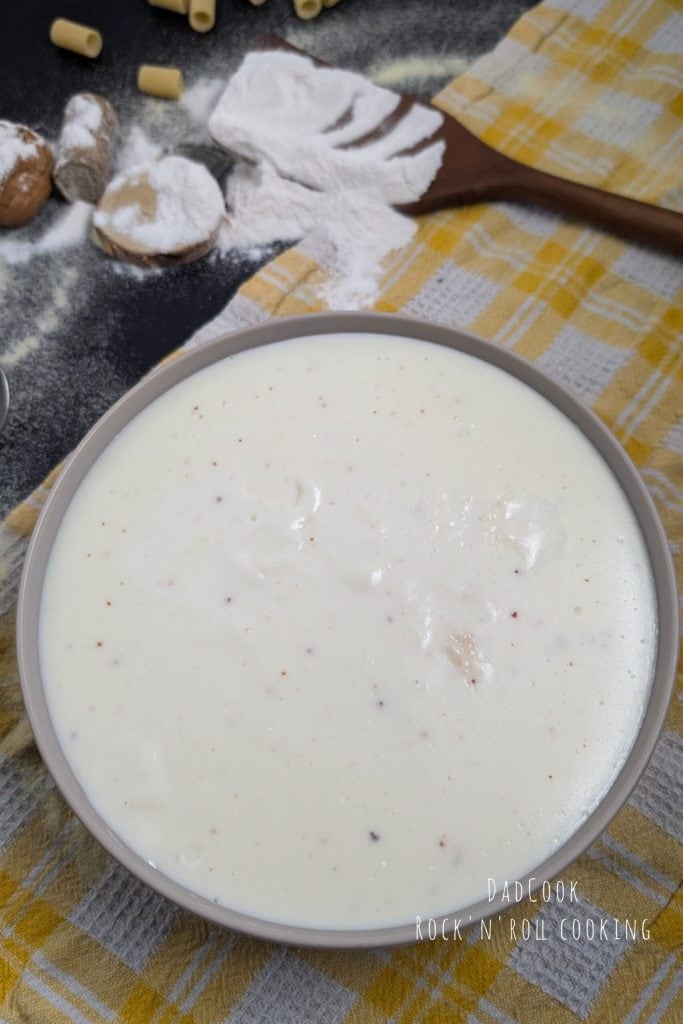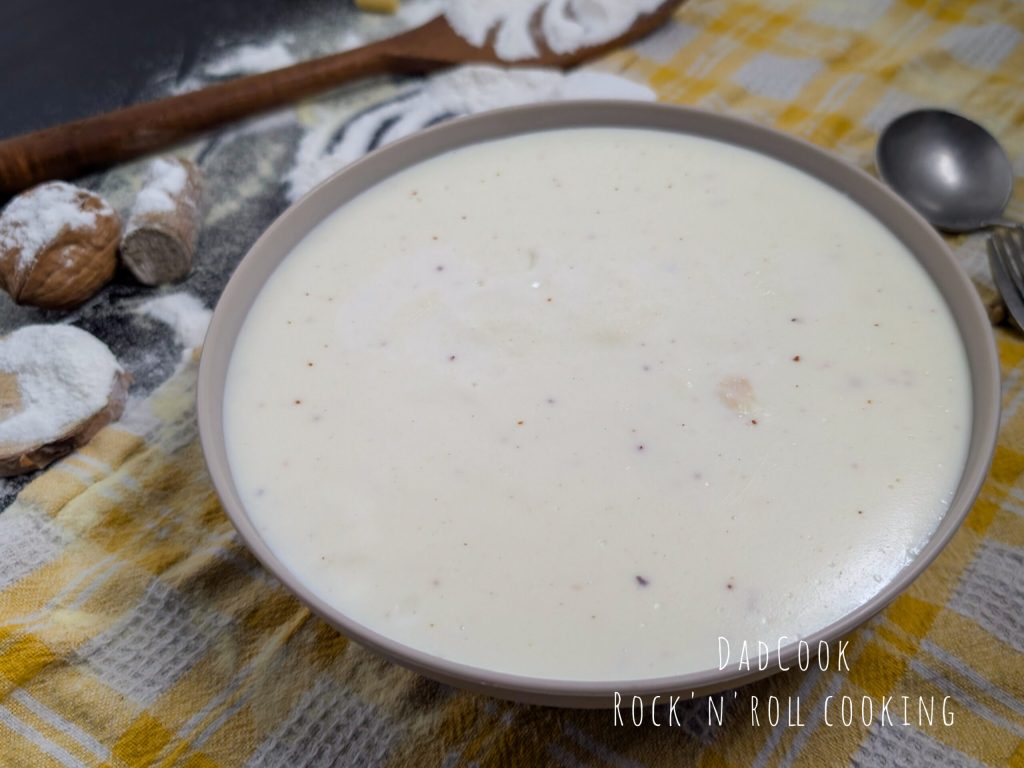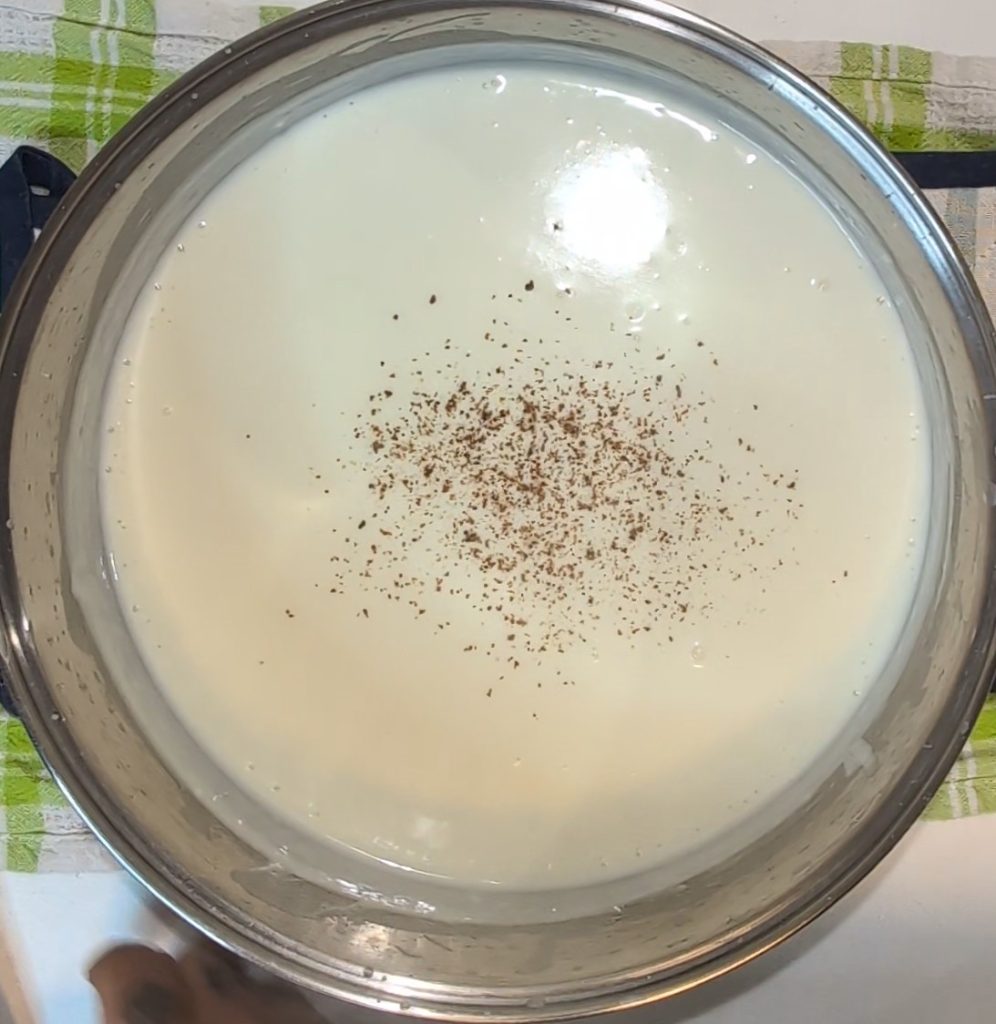Béchamel: a sauce that immediately evokes a sense of comfort and familiarity.
It’s a simple preparation, but with an extraordinary power: turning ordinary dishes into memorable creations. Its delicate flavor and velvety texture make it a versatile ingredient, perfect for seasoning baked pasta, gratinéed vegetables, lasagna, and much more.
But the truth is that béchamel is so good that I feel like eating it all with a spoon even before using it for the recipe!
Making béchamel sauce is a gesture that takes me back to my childhood, to my grandmother’s kitchen.
I still remember the smell of butter melting slowly on the stove, the flour blending with the warm milk creating a smooth and silky cream, and finally the unmistakable aroma of nutmeg spreading in the air. And then, that magical moment when my grandmother, with a smile, dipped the spoon into the freshly made béchamel to taste it, “sneaking” that first delightful bite that made her eyes shine. A gesture that repeated every time, like a family ritual that always made my grandfather angry because “you’ll finish it before the pasta is ready!
Today, when I make béchamel, I find myself repeating that gesture almost unconsciously. It’s a way to feel closer to her, to relive those moments of joy and sharing that marked my childhood. And even though I know I should resist the temptation, I can’t help but “steal” a taste, just like she did, with closed eyes and a smile of pure satisfaction.
P.S.: If you have any doubts or questions about making béchamel, check out the FAQ section below at the end of the recipe! I’ve gathered the most frequently asked questions, with their answers, to help you make a perfect béchamel sauce.

- Difficulty: Very Easy
- Cost: Very Economical
- Rest time: 5 Minutes
- Preparation time: 5 Minutes
- Portions: 8
- Cooking methods: Slow Cooking, Low Heat
- Cuisine: Italian
- Seasonality: All Seasons, Christmas
Ingredients
- 4 1/4 cups milk
- 3 1/2 tbsp butter
- 1/3 cup flour
Tools
- 1 Saucepan Vier
Steps
To start, place the cubed butter in a heavy-bottomed pan. Let it melt completely over low heat, stirring occasionally with a wooden spoon, almost guiding it through this sweet transformation.
Continue until you achieve a homogeneous liquid, smooth as molten gold, ready for the next step.

Once the butter has completely melted into a golden, velvety liquid, it is time to add the flour. But beware: before proceeding, remove the pan from the heat. This small precaution will prevent the flour from burning upon contact with the hot butter, compromising the delicate flavor of the béchamel.
Now, pour the flour all at once into the pan, and start stirring vigorously with a whisk. Work the mixture with rapid and decisive movements, blending the flour with the melted butter until you obtain a thick, homogeneous cream without lumps.
This cream, known as roux, is the base of béchamel, and its smooth consistency is fundamental for the success of the sauce.
Continue stirring for a couple of minutes until the roux takes on a light golden color and a delicate biscuit scent.

Now that the roux, our butter and flour base, is ready, we can return the pan to the heat, to low flame. It’s time to add the milk, the ingredient that will give the béchamel its characteristic creaminess.
But be careful: the milk should be added in a thin stream, little by little, and not all at once.
Pour a first drop of milk into the roux and stir quickly with the whisk, incorporating it completely. Continue this way, adding the milk in a thin stream and stirring continuously, until you have poured all the milk into the pan.
This slow and gradual inclusion of milk is essential to avoid the formation of lumps, ensuring a smooth and velvety béchamel. While stirring, you will see the sauce transform, thicken, and become increasingly creamy.
Continue cooking over low heat for a few minutes, stirring occasionally, until the béchamel reaches the desired consistency.

Once the béchamel has reached the desired consistency, thick and velvety, remove it from the heat once again.
It’s time to complete our sauce with the final touches that will enhance its flavor and make it irresistible.
Add a pinch of salt, adjusting the quantity based on your taste and the recipe you intend to prepare. For an extra touch of aroma, grate a generous amount of fresh nutmeg, which with its warm and enveloping scent, pairs perfectly with the creaminess of the béchamel. Stir carefully, blending the salt and nutmeg into the sauce.
At this point, your béchamel is ready!

The béchamel is ready! Transfer the béchamel to a container.
Let it cool slightly and use it to add a touch of creaminess and flavor to your favorite recipes: lasagna, cannelloni, baked pasta, gratinéed vegetables… the possibilities are endless! Enjoy your meal!

Storage, Tips, and Useful Variations for Homemade Béchamel:
Storage:
Once ready, the béchamel can be used immediately or stored for future use. If you use it immediately, transfer it to a baking dish and cover it with plastic wrap, ensuring the wrap adheres to the surface of the sauce to prevent a skin from forming. If you want to store it, once cooled, place it in an airtight container and keep it in the refrigerator for up to 3 days.
Alternatively, you can freeze it for about a month: in this case, remember to thaw it in the refrigerator the night before using it.
Variations:
There are countless ways to customize your béchamel and make it even tastier. For instance, you can enrich it with grated cheese, such as Parmesan, pecorino, or Gruyère, added at the end of cooking. Or you can turn it into a vegetable béchamel by adding cooked and blended vegetables, like spinach, zucchini, or carrots.
Tips:
For a more aromatic touch, you can flavor it with other spices, like black pepper, herbs, or a pinch of paprika. Let your imagination and taste guide you to create the perfect béchamel for every occasion!
How to Use Homemade Béchamel:
Béchamel is an incredibly versatile sauce, a true kitchen staple!
Here are some ideas on how to use it:First Courses:
Lasagna:
The classic par excellence! Béchamel is the creamy element that ties the layers of pasta, ragù, and cheese.
Cannelloni:
Perfect for blending the filling and adding softness to these delicious pasta rolls.
Baked Pasta:
A triumph of flavors and textures, where the béchamel blends with pasta, cheeses, and other desired ingredients (sausage, vegetables, mushrooms…).
Crepes:
A delicate and refined alternative, where béchamel can be used both to fill the crepes and to create an accompanying sauce.
Roman-style Gnocchi:
An extra touch of creaminess for this traditional dish.
Stuffed Shells:
Béchamel binds the filling and creates a golden crust on top.
Pasta Timbales:
An elegant and scenic first course where béchamel helps create a compact and flavorful consistency.
Main Courses:
Gratinéed Vegetables:
Cauliflower, broccoli, fennel, potatoes… béchamel makes gratinéed vegetables even more appetizing.
Vegetable Flans:
Zucchini, carrots, spinach… béchamel binds the ingredients and adds softness to the flans.
Meatballs:
A secret ingredient to make meatballs even softer and more flavorful.
Croquettes:
Béchamel is the base of the dough for many croquettes, adding creaminess and texture.
Eggplant Parmigiana:
A classic of Italian cuisine, where béchamel alternates with layers of fried eggplants, sauce, and cheese.
Other Ideas:
Creams and Soups:
Adding a spoonful of béchamel to vegetable creams and soups will make them denser and creamier.
Sauces:
Béchamel can be used as a base to create other sauces by adding cheeses, spices, or herbs.
Fillings:
Ideal for filling savory pies and other finger foods.
Tips:
For a lighter béchamel, use low-fat milk.
If the béchamel is too thick, you can dilute it with a bit of hot milk.
If lumps form, you can strain the béchamel with a fine-mesh sieve.
To prevent a skin from forming on the surface, cover the béchamel with plastic wrap in contact.
I hope these tips are helpful!
Enjoy your meal! 😋
FAQ (Frequently Asked Questions)
What are the basic ingredients of béchamel?
Classic béchamel is made with butter, flour, and milk. The standard proportions are 3 1/2 tbsp butter, 1/3 cup flour, and 2 cups milk.

Can I use whole wheat flour to make béchamel?
Yes, you can use whole wheat flour, but the flavor of the béchamel will be slightly more rustic and the color darker.
What type of milk is best for béchamel?
Whole fresh milk is ideal, but you can also use low-fat milk for a lighter béchamel.
How can I avoid lumps in béchamel?
To avoid lumps, it is important to: Add cold milk slowly in a thin stream, stirring continuously with the whisk. Use a heavy-bottomed pan to prevent the béchamel from sticking. If lumps still form, strain the béchamel with a fine-mesh sieve.

What can I do if the béchamel is too liquid?
If the béchamel is too liquid, you can thicken it by cooking it over low heat for a few more minutes, stirring continuously.
Can I flavor the béchamel?
Of course! You can add nutmeg, black pepper, herbs, or grated cheeses like Parmesan, pecorino, or Gruyère.

How is béchamel stored?
Béchamel is stored in the refrigerator, in an airtight container, for up to 3 days. You can also freeze it.
Can I use béchamel to dress pasta?
Absolutely yes! Béchamel is great for dressing baked pasta, lasagna, cannelloni, and many other first courses.
What is roux?
Roux is the butter and flour mixture prepared as a base for béchamel.

Can I make béchamel without butter?
Yes, there are variations of béchamel without butter, using oil or other vegetable fats.
Is béchamel gluten-free?
Classic béchamel contains gluten due to the flour. For a gluten-free version, you can use rice flour or other gluten-free flours.
Where can I find more recipes with béchamel?
You can find many recipes with béchamel in cookbooks, websites, and cooking blogs.

